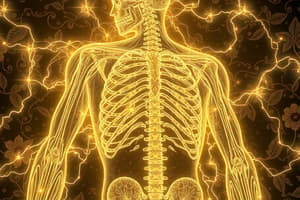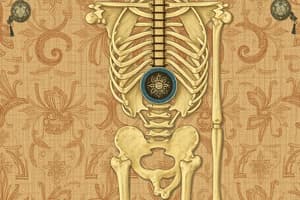Podcast
Questions and Answers
What does biomechanics primarily focus on?
What does biomechanics primarily focus on?
- Fluid dynamics of the cardiovascular system
- Nutritional physiology of muscles
- Movements about joints (correct)
- Chemical processes in muscle contraction
What aspect of movements is NOT typically included in kinematics measurements?
What aspect of movements is NOT typically included in kinematics measurements?
- Muscle force generation (correct)
- Angles
- Types of movements about joints
- Velocity
Which of the following best describes kinetics?
Which of the following best describes kinetics?
- Investigation of muscle force production (correct)
- Analysis of joint angles during movement
- Monitoring of angular extent in movements
- Study of distances moved in joint actions
Which of the following factors is least likely to be associated with the study of biomechanics?
Which of the following factors is least likely to be associated with the study of biomechanics?
What do measurements in kinematics typically include?
What do measurements in kinematics typically include?
Which of the following statements regarding movements about joints is true?
Which of the following statements regarding movements about joints is true?
What is a key characteristic of kinesiology within the study of biomechanics?
What is a key characteristic of kinesiology within the study of biomechanics?
How can movements about joints be described?
How can movements about joints be described?
What is the term used to describe the force at the end of the lever arm?
What is the term used to describe the force at the end of the lever arm?
How can the moment arm (MA) be calculated according to the given example?
How can the moment arm (MA) be calculated according to the given example?
What does the impact force generated by the distal limb correlate to in humans?
What does the impact force generated by the distal limb correlate to in humans?
According to the principles of Newtonian mechanics, what must be considered alongside the foot force?
According to the principles of Newtonian mechanics, what must be considered alongside the foot force?
During normal walking, how much pressure is observed at full extension during heel strike?
During normal walking, how much pressure is observed at full extension during heel strike?
What effect does walking downstairs have on knee pressure?
What effect does walking downstairs have on knee pressure?
What was measured in vivo in the study regarding knee replacement loading?
What was measured in vivo in the study regarding knee replacement loading?
How can the measurement of foot forces be expressed?
How can the measurement of foot forces be expressed?
What is the primary advantage of a type 1 lever in biomechanics?
What is the primary advantage of a type 1 lever in biomechanics?
What mechanical advantage (MA) does a type 3 lever with a lever arm of 0.05m and a load arm of 0.35m have?
What mechanical advantage (MA) does a type 3 lever with a lever arm of 0.05m and a load arm of 0.35m have?
What is true regarding isotonic shortening of the biceps brachii?
What is true regarding isotonic shortening of the biceps brachii?
How is mechanical advantage (MA) defined in biomechanics?
How is mechanical advantage (MA) defined in biomechanics?
Which type of lever is characterized by always having a mechanical advantage of less than 1?
Which type of lever is characterized by always having a mechanical advantage of less than 1?
What is an example of a biomechanical feature that utilizes leverage at the human knee?
What is an example of a biomechanical feature that utilizes leverage at the human knee?
What influences the amount of muscle force required for movement?
What influences the amount of muscle force required for movement?
Force in biomechanics is measured in which unit?
Force in biomechanics is measured in which unit?
What role did biomechanics play in the 20th century development of prosthetics?
What role did biomechanics play in the 20th century development of prosthetics?
Which of the following describes the equation for calculating force due to gravity on an object?
Which of the following describes the equation for calculating force due to gravity on an object?
How can the forces acting about joints be quantified?
How can the forces acting about joints be quantified?
What characteristic of long bones helps improve stability and reduce forces?
What characteristic of long bones helps improve stability and reduce forces?
Which types of joints allow for rotational movement?
Which types of joints allow for rotational movement?
What is kinematics concerned with in biomechanics?
What is kinematics concerned with in biomechanics?
What instrument is typically used to measure angles in movements?
What instrument is typically used to measure angles in movements?
What type of joint is exemplified by the knee?
What type of joint is exemplified by the knee?
Flashcards
Biomechanics
Biomechanics
The study of the mechanical principles of biological systems.
Kinematics
Kinematics
The study of motion, without considering the forces acting on the body. It involves describing the movement of the body in terms of distance, angles, speed, and acceleration.
Kinetics
Kinetics
The study of forces that cause movement and the effects of these forces on the body.
Kinesiology
Kinesiology
Signup and view all the flashcards
Angles
Angles
Signup and view all the flashcards
Muscle Force Generation
Muscle Force Generation
Signup and view all the flashcards
Foot & Ground Reaction Force
Foot & Ground Reaction Force
Signup and view all the flashcards
Joint Pressures
Joint Pressures
Signup and view all the flashcards
What is the stress our bodies experience even when lying down?
What is the stress our bodies experience even when lying down?
Signup and view all the flashcards
What's kinetics?
What's kinetics?
Signup and view all the flashcards
What's kinematics?
What's kinematics?
Signup and view all the flashcards
How does joint shape affect force distribution?
How does joint shape affect force distribution?
Signup and view all the flashcards
Give some examples of types of movement?
Give some examples of types of movement?
Signup and view all the flashcards
What's a goniometer?
What's a goniometer?
Signup and view all the flashcards
What are dynamometers?
What are dynamometers?
Signup and view all the flashcards
Type 1 Lever
Type 1 Lever
Signup and view all the flashcards
Type 2 Lever
Type 2 Lever
Signup and view all the flashcards
Type 3 Lever
Type 3 Lever
Signup and view all the flashcards
Mechanical Advantage (MA)
Mechanical Advantage (MA)
Signup and view all the flashcards
Lever Arm (IMA)
Lever Arm (IMA)
Signup and view all the flashcards
Load Arm (EMA)
Load Arm (EMA)
Signup and view all the flashcards
Muscle Force
Muscle Force
Signup and view all the flashcards
Moment (Lever Arm Force)
Moment (Lever Arm Force)
Signup and view all the flashcards
Ground Reaction Force
Ground Reaction Force
Signup and view all the flashcards
Foot Force
Foot Force
Signup and view all the flashcards
Foot Force Measurement
Foot Force Measurement
Signup and view all the flashcards
Plate Transducer
Plate Transducer
Signup and view all the flashcards
Knee Pressure During Walking
Knee Pressure During Walking
Signup and view all the flashcards
Increased Knee Pressure During High Impact
Increased Knee Pressure During High Impact
Signup and view all the flashcards
Study Notes
Musculoskeletal Physiology - Biomechanics
- This course covers the biomechanics of the musculoskeletal system, focusing on how movements are measured and forces are generated.
- The course will include the study of introductory concepts, measuring movements (kinematics), and measuring force and speed (kinetics).
- Kinematics examines the types of movements around joints, angles, and lever systems.
- Kinetics investigates muscle force generation, ground reaction forces, and joint pressures.
- Biomechanics applies engineering principles to understand how the human body functions, particularly regarding joint movements.
- Biomechanics also considers the cardiovascular system, but primarily focuses on joint movements.
- Measurement of movement involves using goniometers to measure angles.
- Levers are a key concept, with three types (first, second, and third class) categorized by the positioning of the load, fulcrum, and force.
- Types of movements at joints include hinge, ball-and-socket, pivot, saddle, and mortise-tenon joints.
- Forces of movement, such as those related to body weight, can be measured in the laboratory.
- The force exerted on a joint is also affected by shape, where broad ends help reduce forces.
Studying That Suits You
Use AI to generate personalized quizzes and flashcards to suit your learning preferences.
Related Documents
Description
Explore the biomechanics of the musculoskeletal system, focusing on kinematics and kinetics. This quiz covers introductory concepts, measurements of movement, and how forces are generated during joint movements. Understand the principles of levers and the applications in human body mechanics.




